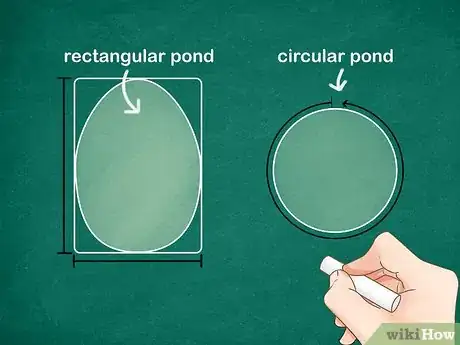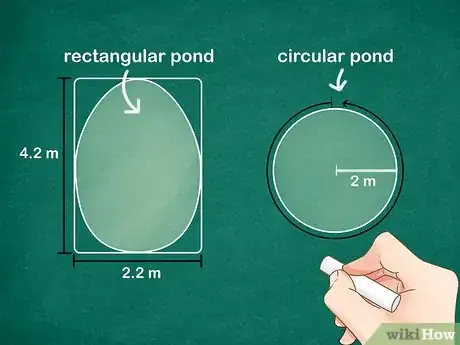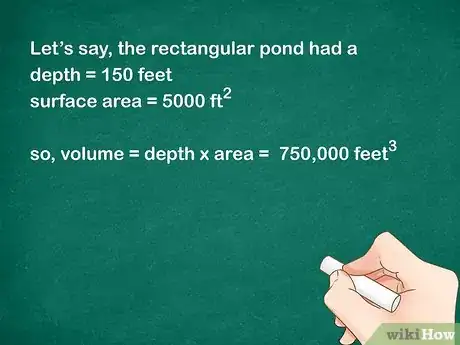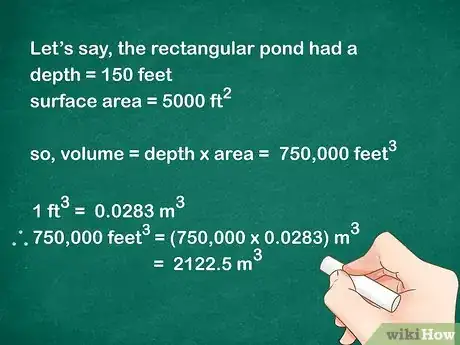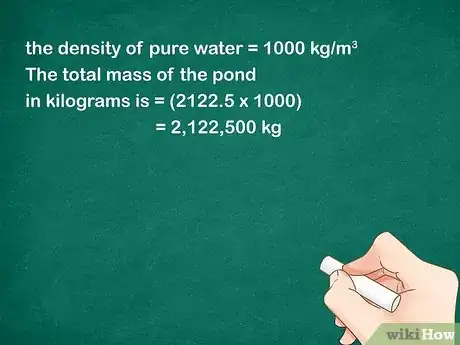This article was co-authored by wikiHow Staff. Our trained team of editors and researchers validate articles for accuracy and comprehensiveness. wikiHow's Content Management Team carefully monitors the work from our editorial staff to ensure that each article is backed by trusted research and meets our high quality standards.
There are 8 references cited in this article, which can be found at the bottom of the page.
This article has been viewed 58,364 times.
Learn more...
When you want to know the weight of something, you usually just place the object on a scale and record the output. What if you wanted to know the weight of an ocean or your swimming pool? Obviously, you can't put your pool on a scale. With some simple estimations, you can calculate the volume of the body of water and then convert that to weight using the density of water.[1] Keep in mind that this calculation will be an estimation of the weight and not an exact calculation.
Steps
Determining the Volume of the Body of Water
-
1Assess the shape of the body of water. You need to calculate the volume of the particular body of water you are interested in. To do this, you need a rough estimation of the total area of the surface of the body which you will then multiply by the depth.[2]
- If you are looking at a rectangular swimming pool, you will simply use length times width to find the area.
- If the body of water is more of a circular lake or pond, you will want to use an equation for the area of a circle.
- If you want to estimate the weight of an ocean, it is best to look up the total area of the ocean itself.
-
2Take measurements of the body of water. To calculate the surface area and volume, you will need to either look up some measurements or take them yourself. Use measuring tools such as long tape measures (often used for surveying) for your estimations.
- If the body of water is mostly rectangular, you want to measure the approximate length and width of the body.
- If the body is circular, you will need to estimate its radius. To find the diameter, simply multiply the radius by 2.[3]
Advertisement -
3Approximate the surface area of the body of water. Once you have assessed the shape of the body of water and made measurements, you can calculate the approximate area that the surface of the body takes up. The area calculation will be based on the shape that you previously determined when assessing the body of water at the beginning.
- For a rectangle shape, simply multiply the length times the width.[4] Let's say you had a small pond in your yard that was 100 feet by 50 feet. The total area of the pond would be 5000 ft2.
- For a circular shape, use the formula A = πr2 where r is the radius of the body of water.[5] Let's say your pond was more of a circular shape with a radius of about 200 feet. The area of the pond would be π(200)2 = 125,600 ft2.
-
4Estimate the average depth of the body of water. To estimate the average depth, take measurements evenly spaced throughout the entire pond from both the shallow and deep areas. Add up all of these measurements and then divide by the total number of measurements. This will give you a good estimation of the average depth of the body.
- Alternatively, you can try to look up the depth of the body of water if it is well-known lake or ocean.
-
5Multiply the total surface area and depth to calculate the volume. The final step in calculating the volume of the body of water is to multiply the total surface area by the average depth. Remember, this is still an approximation because some liberties were taken with the measurements.
- For example: Let's say the rectangular pond had a depth of 150 feet. It had a surface area of 5000 ft2 so multiplying that by 150 feet gives you an approximate volume of 750,000 feet3.
Calculating the Weight
-
1Convert the volume to meters cubed. At this point, the calculation becomes much simpler if you convert from imperial units to metric units. When you are finished with all of the calculations you can convert kilograms back to pounds to get the weight in imperial units.
- To convert cubic feet to cubic meters, use the conversion factor 0.0283 m3/ft3.[6]
- For the rectangular pond, multiply (750,000 ft3)(0.0283) = 2122.5 m3.
-
2Identify the density of the liquid of the body of water. Density is affected by temperature and salinity (salt content) so the density of water in a warm freshwater lake will be different than that of an arctic ocean. If you are doing a rough estimation you can use a density of 1000 kg/m3 (the density of pure water).[7]
- Ocean water is more dense because of the salt content and is about 1027 kg/m3.
- Colder water is more dense than warmer water, but for this type of general calculation the changes due to temperature can be ignored.
-
3Multiply volume by density to calculate mass. The next step in getting to the weight of your body of water is converting the total volume you calculated into a mass. This is done by multiplying by the density of the liquid.[8]
- For example: The pond contains fresh water, so use the density of water of 1000 kg/m3. Multiply the volume in m3 by this density: (2122.5)(1000) = 2,122,500 kg. The total mass of the pond in kilograms is 2,122,500.
-
4Convert mass to weight in pounds. The final step is to convert kilograms back to pounds. To do this, you use the conversion factor 2.2 kg/lb. Simply multiply the number of kilograms by 2.2 to get the number of pounds.[9]
- For example: 2,122,500 x 2.2 = 4,669,500 lbs. The total weight of the pond is 4,669,500 pounds.
Community Q&A
-
QuestionWeight of 200 liters of water in drums is equal to how many kg?
 DonaganTop AnswererEach liter of water weighs one kilogram.
DonaganTop AnswererEach liter of water weighs one kilogram. -
QuestionIf I weigh 240 lbs. on land, how much do I weigh in 4 feet of fresh water?
 DonaganTop AnswererIt depends on how "buoyant" your body is (which in turn depends on how much air is in your lungs at any given moment). Most people can float when fully immersed in freshwater, in which case they literally weigh nothing. If they weighed anything, they would slowly sink to the bottom of the water.
DonaganTop AnswererIt depends on how "buoyant" your body is (which in turn depends on how much air is in your lungs at any given moment). Most people can float when fully immersed in freshwater, in which case they literally weigh nothing. If they weighed anything, they would slowly sink to the bottom of the water. -
QuestionWhat's the weight of a brick in air? And in water?
 DonaganTop AnswererBricks vary in weight depending on their composition. A brick in water is lighter in weight than the same brick in air to the extent that air was trapped inside the brick during its construction.
DonaganTop AnswererBricks vary in weight depending on their composition. A brick in water is lighter in weight than the same brick in air to the extent that air was trapped inside the brick during its construction.
References
- ↑ http://www.thecalculatorsite.com/articles/units/how-to-convert-volume-to-weight.php
- ↑ http://www.vertexwaterfeatures.com/aeration/pond-or-lake-surface-area-volume-calculator
- ↑ https://www.mathsisfun.com/geometry/circle.html
- ↑ https://www.mathgoodies.com/lessons/vol1/area_rectangle
- ↑ https://www.mathgoodies.com/lessons/vol2/circle_area
- ↑ http://www.asknumbers.com/CubicFeetToCubicMeter.aspx
- ↑ http://www.windows2universe.org/earth/Water/density.html
- ↑ http://www.thecalculatorsite.com/articles/units/how-to-convert-volume-to-weight.php
- ↑ http://www.metric-conversions.org/weight/kilograms-to-pounds.htm
